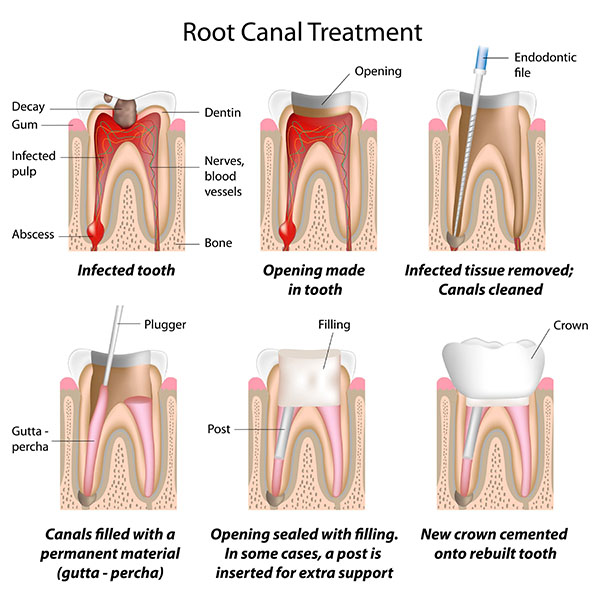 After root canal therapy, you may need to reinforce your tooth with a dental crown. This treatment may weaken your tooth and require a permanent dental restoration to remain healthy. Some people get fillings instead of crowns as a restoration for a root canal treatment, but in most cases, a dental crown is a better option.
After root canal therapy, you may need to reinforce your tooth with a dental crown. This treatment may weaken your tooth and require a permanent dental restoration to remain healthy. Some people get fillings instead of crowns as a restoration for a root canal treatment, but in most cases, a dental crown is a better option.
To Restore a Fragile Tooth
A tooth can become more fragile following root canal therapy since we have to drill into the tooth to gain access to the infection. On top of that, the tooth becomes weak from the cavity or infection prior to any procedure. By the end of this treatment, the structure will not be as strong as it once was and it may be missing a large piece of itself. Exposure to everyday functions like eating and speaking can cause damage with ease. A durable dental crown can cover this tooth to make it stronger for use while preventing fractures or chips.
To Protect a Tooth from Sensitivity
After root canal therapy, some remaining nerves may become extra sensitive to heat and cold. This can get frustrating very quickly, which is another reason to cover the tooth with a dental crown after root canal therapy.
To Keep a Natural-Looking Color
Some teeth suffer changes in color following a root canal treatment. If a tooth looks grayed or deeply discolored, a dental crown can provide a more natural-looking appearance and a whiter color to match the other teeth.
To Keep a Tooth Safe from Infection
Following root canal therapy, the surface of the tooth is at a greater risk of infection and contamination. To avoid recontamination, also known as a failed root canal treatment, a dental crown will be placed over the tooth to seal it off from harmful leakage so you will not have to have your tooth extracted.
Back Up Security
Most teeth that have to undergo root canal therapy have already once had a cavity before this time. A tooth with a significant history of decay should not be sealed with a filling. Fillings do provide some protection, but normally not nearly enough for a vulnerable tooth like this one would represent. Any tooth that has already once had a filling suffered extensive decay previously, was chipped or fractured prior to root canal treatment, or that is in a high traffic area should most definitely be restored with a dental crown.
Following root canal therapy, it is imperative that you receive a dental crown or another form of restoration for your tooth. Now your tooth is more susceptible to damage than ever before and it should not be left in a vulnerable condition. Visit our Bellevue office to learn more about receiving a dental crown that is durable, stain resilient, and attractive after a root canal treatment.
Related Posts
When a Dental Crown Is Needed for a Cavity
A dental crown is often used to treat dental cavities, especially when the cavity is too large or too deep for a dentist to repair with a dental filling. This review …
Dental Crown to Restore a Damaged Tooth
A tooth with significant damage will need a dental crown or cap. This restoration can restore the form and function of your tooth. Getting a large filling or a root canal …
What to Expect in a Dental Crown Procedure
When a filling is insufficient or a tooth is malformed, the dentist may suggest a dental crown to protect, cover, and restore the tooth's structure. While receiving a crown may seem …
Dental Crowns to Restore a Tooth's Shape and Size
Having dental crowns can change the way your mouth looks. Any distortion in the size and shape of your teeth can disappear with the help of caps. Crowns are custom-fit restorations …
